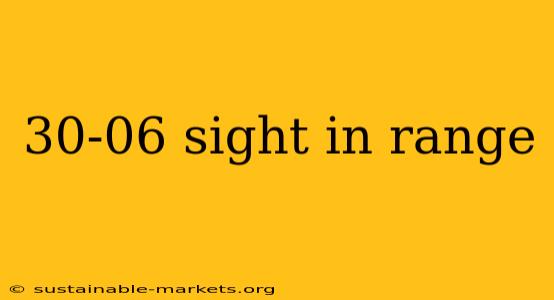Choosing the right sight-in range for your .30-06 Springfield rifle is crucial for achieving accurate shots at various hunting and target shooting distances. This comprehensive guide will delve into the factors influencing sight-in range selection, provide practical advice, and offer strategies for optimal zeroing.
Understanding the Importance of Sight-In Range
The process of "sighting in" a rifle involves adjusting the sights (or scope) to ensure the bullet impacts the target at the desired point of aim. The chosen sight-in range directly impacts your bullet's trajectory at other distances. A poorly chosen range can lead to significant misses, especially at longer distances.
Factors Influencing Sight-In Range Selection:
-
Intended Use: Are you primarily hunting deer at 100-300 yards, or are you focused on long-range target shooting? Your sight-in range should align with your typical shooting distances.
-
Bullet Trajectory: .30-06 Springfield cartridges exhibit a distinct ballistic trajectory. Understanding your specific ammunition's trajectory is essential. Ballistic charts (often found on ammunition boxes or online) provide data on bullet drop at different ranges.
-
Rifle & Scope: The specific rifle and scope combination will influence the sight-in process. Different scopes have different adjustments and magnification capabilities.
-
Personal Preferences: Some shooters prefer a sight-in range that results in a flat trajectory within a specific distance, while others prioritize a specific point of impact at a critical hunting distance.
Common Sight-In Ranges for .30-06 Springfield
While there's no universally "best" sight-in range, some popular choices for the .30-06 include:
100 Yards:
- Pros: A common and easily accessible range. Provides a good starting point for understanding your rifle's zero. Relatively forgiving for minor sight adjustments.
- Cons: May not accurately reflect bullet drop at longer ranges. Requires more precise adjustments for longer-distance shooting.
200 Yards:
- Pros: Offers a better representation of bullet trajectory compared to 100 yards. Suitable for hunters who frequently shoot within a 200-yard range.
- Cons: Requires access to a 200-yard range. Less forgiving of minor sight adjustments.
25-50 Yards (for initial boresighting):
- Pros: Ideal for initial zeroing to get the rifle "on paper". This step helps prevent wasting ammunition during the initial sighting-in process. Minimizes safety hazards when sighting in.
- Cons: Doesn't give a complete picture of the trajectory at longer ranges. It's the first step but not the final zeroing distance.
Choosing the Right Sight-In Range for You
For most hunters who shoot within a 300-yard range, a 200-yard sight-in is a solid choice. It provides a balance between accuracy at hunting distances and the practicality of range availability. For long-range target shooters, a longer range might be more appropriate.
If you're unsure which range to choose, consider these steps:
- Consult ballistic charts: Determine the bullet drop of your specific ammunition at various ranges.
- Consider your typical shooting distances: Choose a sight-in range that's representative of your usual hunting or target shooting distances.
- Start with a shorter range: Boresight your rifle at a shorter range (25-50 yards) to get it close.
- Gradually increase the range: Refine your sight-in at longer ranges.
Practical Tips for Sight-In
- Use a stable shooting rest: A stable shooting rest is essential for accurate sight-in.
- Shoot multiple groups: Shoot at least three groups of three shots at each range to assess accuracy.
- Make small adjustments: Make small, incremental adjustments to your sights or scope.
- Record your adjustments: Keep track of the adjustments you make to your sights or scope.
- Consider professional help: If you're struggling to sight in your rifle, seek professional help from a gunsmith or experienced shooter.
By carefully considering these factors and following the tips above, you can choose the optimal sight-in range for your .30-06 Springfield rifle and achieve the accuracy you need for hunting or target shooting. Remember safety is paramount – always follow safe gun handling practices.

